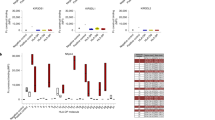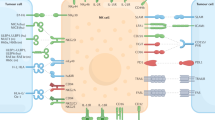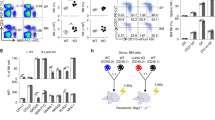Abstract
Self versus non-self discrimination is a central theme in biology from plants1 to vertebrates, and is particularly relevant for lymphocytes that express receptors capable of recognizing self-tissues and foreign invaders. Comprising the third largest lymphocyte population, natural killer (NK) cells recognize and kill cellular targets and produce pro-inflammatory cytokines. These potentially self-destructive effector functions can be controlled by inhibitory receptors for the polymorphic major histocompatibility complex (MHC) class I molecules that are ubiquitously expressed on target cells2,3,4. However, inhibitory receptors are not uniformly expressed on NK cells, and are germline-encoded by a set of polymorphic genes that segregate independently from MHC genes5,6. Therefore, how NK-cell self-tolerance arises in vivo is poorly understood. Here we demonstrate that NK cells acquire functional competence through ‘licensing’ by self-MHC molecules. Licensing involves a positive role for MHC-specific inhibitory receptors and requires the cytoplasmic inhibitory motif originally identified in effector responses. This process results in two types of self-tolerant NK cells—licensed or unlicensed—and may provide new insights for exploiting NK cells in immunotherapy. This self-tolerance mechanism may be more broadly applicable within the vertebrate immune system because related germline-encoded inhibitory receptors are widely expressed on other immune cells.
This is a preview of subscription content, access via your institution
Access options
Subscribe to this journal
Receive 51 print issues and online access
$199.00 per year
only $3.90 per issue
Buy this article
- Purchase on Springer Link
- Instant access to full article PDF
Prices may be subject to local taxes which are calculated during checkout





Similar content being viewed by others
References
Murase, K. et al. A membrane-anchored protein kinase involved in Brassica self-incompatibility signalling. Science 303, 1516–1519 (2004)
Karlhofer, F. M., Ribaudo, R. K. & Yokoyama, W. M. MHC class I alloantigen specificity of Ly-49+ IL-2-activated natural killer cells. Nature 358, 66–70 (1992)
Lanier, L. L. NK cell receptors. Annu. Rev. Immunol. 16, 359–393 (1998)
Moretta, L., Biassoni, R., Bottino, C., Mingari, M. C. & Moretta, A. Human NK-cell receptors. Immunol. Today 21, 420–422 (2000)
Trowsdale, J. Genetic and functional relationships between MHC and NK receptor genes. Immunity 15, 363–374 (2001)
Yokoyama, W. M. & Plougastel, B. F. Immune functions encoded by the natural killer gene complex. Nature Rev. Immunol. 3, 304–316 (2003)
Bix, M. et al. Rejection of class I MHC-deficient haemopoietic cells by irradiated MHC-matched mice. Nature 349, 329–331 (1991)
Furukawa, H. et al. Tolerance of NK and LAK activity for HLA class I-deficient targets in a TAP1-deficient patient (bare lymphocyte syndrome type I). Hum. Immunol. 60, 32–40 (1999)
Raulet, D. H., Vance, R. E. & McMahon, C. W. Regulation of the natural killer cell receptor repertoire. Annu. Rev. Immunol. 19, 291–330 (2001)
Sentman, C. L., Olsson, M. Y. & Karre, K. Missing self recognition by natural killer cells in MHC class I transgenic mice. A ‘receptor calibration’ model for how effector cells adapt to self. Semin. Immunol. 7, 109–119 (1995)
Kim, S. et al. In vivo developmental stages in murine natural killer cell maturation. Nature Immunol. 3, 523–528 (2002)
Hanke, T. et al. Direct assessment of MHC class I binding by seven Ly49 inhibitory NK cell receptors. Immunity 11, 67–77 (1999)
Nakamura, M. C. et al. Mouse Ly-49D recognizes H2-Dd and activates natural killer cell cytotoxicity. J. Exp. Med. 189, 493–500 (1999)
Bakker, A. B. et al. DAP12-deficient mice fail to develop autoimmunity due to impaired antigen priming. Immunity 13, 345–353 (2000)
Vance, R. E., Kraft, J. R., Altman, J. D., Jensen, P. E. & Raulet, D. H. Mouse CD94/NKG2A is a natural killer cell receptor for the nonclassical major histocompatibility complex (MHC) class I molecule Qa-1(b). J. Exp. Med. 188, 1841–1848 (1998)
Lybarger, L. et al. Enhanced immune presentation of a single-chain major histocompatibility complex class I molecule engineered to optimize linkage of a C-terminally extended peptide. J. Biol. Chem. 278, 27105–27111 (2003)
Brennan, J., Lemieux, S., Freeman, J. D., Mager, D. L. & Takei, F. Heterogeneity among Ly-49C natural killer (NK) cells—characterization of highly related receptors with differing functions and expression patterns. J. Exp. Med. 184, 2085–2090 (1996)
Doucey, M. A. et al. Cis association of Ly49A with MHC class I restricts natural killer cell inhibition. Nature Immunol. 5, 328–336 (2004)
Andersson, M. et al. MHC class I mosaic mice reveal insights into control of Ly49C inhibitory receptor expression in NK cells. J. Immunol. 161, 6475–6479 (1998)
Nakamura, M. C. et al. Mouse Ly-49A interrupts early signalling events in natural killer cell cytotoxicity and functionally associates with the Shp-1 tyrosine phosphatase. J. Exp. Med. 185, 673–684 (1997)
Starr, T. K., Jameson, S. C. & Hogquist, K. A. Positive and negative selection of T cells. Annu. Rev. Immunol. 21, 139–176 (2003)
Long, E. O. Regulation of immune responses through inhibitory receptors. Annu. Rev. Immunol. 17, 875–904 (1999)
Bennett, M. et al. Hybrid resistance: ‘negative’ and ‘positive’ signalling of murine natural killer cells. Semin. Immunol. 7, 121–127 (1995)
Barao, I. & Murphy, W. J. The immunobiology of natural killer cells and bone marrow allograft rejection. Biol. Blood Marrow Transplant. 9, 727–741 (2003)
Ruggeri, L. et al. Effectiveness of donor natural killer cell alloreactivity in mismatched hematopoietic transplants. Science 295, 2097–2100 (2002)
Parham, P. & McQueen, K. L. Alloreactive killer cells: hindrance and help for haematopoietic transplants. Nature Rev. Immunol. 3, 108–122 (2003)
Biron, C. A., Nguyen, K. B., Pien, G. C., Cousens, L. P. & Salazar-Mather, T. P. Natural killer cells in antiviral defense: function and regulation by innate cytokines. Annu. Rev. Immunol. 17, 189–220 (1999)
Yu, Y. Y., Netuschil, N., Lybarger, L., Connolly, J. M. & Hansen, T. H. Cutting edge: single-chain trimers of MHC class I molecules form stable structures that potently stimulate antigen-specific T cells and B cells. J. Immunol. 168, 3145–3149 (2002)
Lybarger, L., Wang, X., Harris, M. R.,, Virgin, H. W. & Hansen, T. H. Virus subversion of the MHC class I peptide-loading complex. Immunity 18, 121–130 (2003)
Furukawa, H., Iizuka, K., Poursine-Laurent, J., Shastri, N. & Yokoyama, W. M. A ligand for the murine NK activation receptor Ly-49D: activation of tolerized NK cells from β2-microglobulin-deficient mice. J. Immunol. 169, 126–136 (2002)
Acknowledgements
Work in the Yokoyama laboratory is supported by the Howard Hughes Medical Institute, the Barnes-Jewish Hospital Foundation and grants from the National Institutes of Health. Transgenic production and genotyping were supported by the Rheumatic Diseases Core Center grant. This study was also supported by an NIH grant to the Hansen laboratory. The authors thank M. Miley and D. Fremont for initial production of the SCT–Kb tetramers, E. Holroyd, J. Mohan, D. Higuchi and R. Rodrigues for technical assistance, and P. Allen, M. Colonna, J. Loh and E. Unanue for critical comments on the manuscript.
Author information
Authors and Affiliations
Corresponding author
Ethics declarations
Competing interests
Reprints and permissions information is available at npg.nature.com/reprintsandpermissions. The authors declare no competing financial interests.
Supplementary information
Supplementary Figure Legends
This file contains figure legends for all six Supplementary Figures. (PDF 79 kb)
Supplementary Figures
Contains Supplementary Figures S1-S6. (PDF 170 kb)
Supplementary Methods
Additional details of methods to accompany those given in the main text. (PDF 36 kb)
Supplementary Notes
This file contains additional references on the study. (PDF 64 kb)
Rights and permissions
About this article
Cite this article
Kim, S., Poursine-Laurent, J., Truscott, S. et al. Licensing of natural killer cells by host major histocompatibility complex class I molecules. Nature 436, 709–713 (2005). https://doi.org/10.1038/nature03847
Received:
Accepted:
Issue Date:
DOI: https://doi.org/10.1038/nature03847
This article is cited by
-
Dysfunctional natural killer cells can be reprogrammed to regain anti-tumor activity
The EMBO Journal (2024)
-
Defining the role of natural killer cells in COVID-19
Nature Immunology (2023)
-
Roles of natural killer cells in immunity to cancer, and applications to immunotherapy
Nature Reviews Immunology (2023)
-
Inhibitory receptors for HLA class I as immune checkpoints for natural killer cell-mediated antibody-dependent cellular cytotoxicity in cancer immunotherapy
Cancer Immunology, Immunotherapy (2023)
-
Associations between KIR/KIR-ligand genotypes and clinical outcome for patients with advanced solid tumors receiving BEMPEG plus nivolumab combination therapy in the PIVOT-02 trial
Cancer Immunology, Immunotherapy (2023)
Comments
By submitting a comment you agree to abide by our Terms and Community Guidelines. If you find something abusive or that does not comply with our terms or guidelines please flag it as inappropriate.



